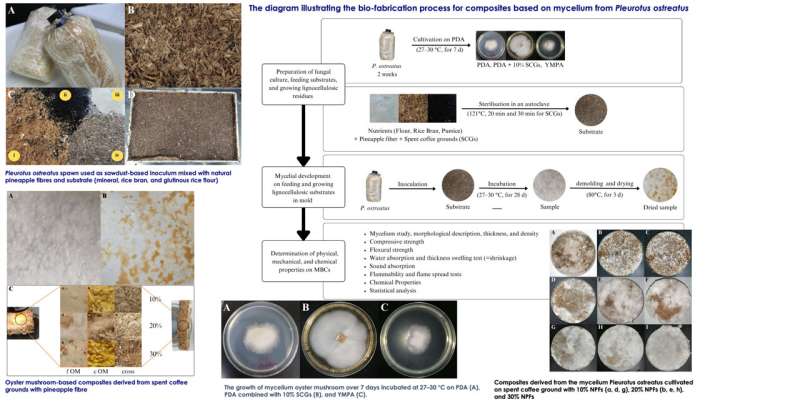This article has been reviewed according to Science X's editorial process and policies. Editors have highlighted the following attributes while ensuring the content's credibility:
fact-checked
proofread
Researchers develop eco-friendly material from mushrooms, coffee grounds and natural pineapple fibers

Researchers have developed a novel eco-friendly material, dubbed "mycelium-based composites (MBCs)." Mycelium-based composites (MBCs) are renowned for their unique properties, making them an increasingly popular choice in various industries, particularly for applications where sustainability and environmental impact are key considerations.
The study, "Fabrication of mycelium (oyster mushroom)-based composites derived from spent coffee grounds with pineapple fibre reinforcement," has been published in Mycology.
One of the standout features of MBCs is their biodegradability. Unlike many synthetic materials, MBCs can be composted at the end of their lifecycle, breaking down into harmless, natural substances, thereby significantly reducing waste and lessening their environmental footprint.
The production process of MBCs is inherently sustainable. These composites are derived from renewable resources, as mycelium—the root structure of fungi—can be grown on various organic waste materials. This approach not only repurposes waste but also ensures that the production of MBCs is eco-friendly, consuming less energy compared to traditional plastics and synthetic materials.
In terms of physical properties, MBCs are highly versatile. Their strength and density can be customized to suit a range of applications, from lightweight packaging solutions to more robust building materials. This flexibility is a key advantage, allowing for a wide range of uses in different contexts.
Moreover, MBCs possess excellent natural insulation properties, both thermal and acoustic, which makes them an attractive option in the construction sector, particularly for insulation panels. Additionally, certain treatments and growth conditions can render these composites fire-resistant, enhancing their safety profile and expanding their applicability in scenarios where fire resistance is crucial.
This innovative study, spearheaded by Dr. Nattawut Boonyuen, a mycologist from the National Center for Genetic Engineering and Biotechnology (BIOTEC) at the National Science and Technology Development Agency (NSTDA), and Dr. Pitak Laoratanakul from the National Metal and Materials Technology Center (MTEC), also at NSTDA, marks a significant advancement in sustainable material sciences.
Collaborating with other researchers from King Mongkut's University of Technology Thonburi (KMUTT) and King Mongkut's Institute of Technology Ladkrabang (KMITL), this innovative research led by Dr. Nattawut Boonyuen resulted in the creation of a novel material that merges oyster mushroom mycelia with used coffee grounds, and marks a significant advancement in the domains of packaging and construction.
This unique blend, further enriched with natural pineapple fibers, signifies a substantial breakthrough in the development of sustainable materials. By adjusting the proportion of pineapple fibers incorporated into the composite, its characteristics can be modified, ranging from increased strength to improved water resistance. This adaptability allows for its application across a diverse array of uses, showcasing its versatility.
The MBCs' fire-resistant nature further underscores their practicality, merging environmental sustainability with safety. This aspect of the composites is particularly noteworthy in the material sciences domain, where such a combination is rare.
This development is more than just an innovation in eco-friendly materials; it symbolizes a significant move towards sustainable living. It exemplifies the extraordinary potential that lies in the confluence of natural elements and scientific ingenuity. As we delve deeper into the exploration of such materials, the use of mushrooms and coffee grounds may well be the harbinger of a broader environmental revolution.
More information: Chatchai Kohphaisansombat et al, Fabrication of mycelium (oyster mushroom)-based composites derived from spent coffee grounds with pineapple fibre reinforcement, Mycology (2023). DOI: 10.1080/21501203.2023.2273355
Provided by Tsinghua University Press





















